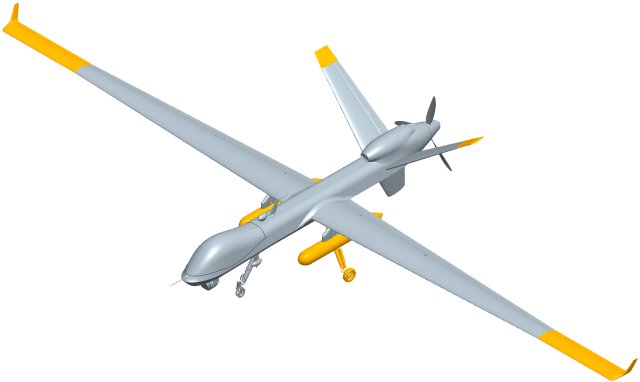General Atomics Aeronautical Systems Inc., Poway, Calif., has been awarded a not-to-exceed $117,286,467 undefinitized contract action (0118) for an existing firm-fixed-price contract (FA8620-10-G-3038) for the MQ-9 Accelerated Extended Range effort which will field 38 MQ-9 Extended Range aircraft. Work will be completed in Poway, Calif., and is expected to be completed by July 7, 2016. Fiscal 2013 research and development funds in the amount of $6,597,174, fiscal 2013 procurement funds in the amount of $31,304,722, and fiscal 2014 research and development funds in the amount of $3,605,250 will be obligated for a total obligation of $41,507,146 at contract award. This award is a result of sole-source acquisition. Air Force Lifecycle Management Center/WIIK, Medium Altitude Unmanned Aircraft Systems, Wright-Patterson Air Force Base, Ohio, is the contracting activity.
General Atomics Aeronautical Systems Inc., Poway, Calif., has been awarded a $16,595,766 delivery order (0114) for an existing contract (FA8620-10-G-3038) for Lead-off Hitter AFSOC MQ-9 Software Line which will provide MQ-9 software engineering support for the AFSOC fleet of MQ-9 unmanned aerial systems. Work will be performed in Poway, Calif., and is expected to be completed by Feb. 6, 2015. Fiscal 2013 research and development funds in the amount of $2,063,006 are being obligated at time of award. Air Force Life Cycle Management Center/WIIK, Medium Altitude Unmanned Aircraft Systems, Wright-Patterson Air Force Base, Ohio, is the contracting activity.
USAF to convert 38 Reaper UASs to Extended Range Capability configuration - IHS Jane's 360
The US Air Force (USAF) is to convert 38 of its 104 General Atomics Aeronautical Systems Inc (GA-ASI) MQ-9 Reaper unmanned aircraft systems (UASs) to the company's Extended Range Capability configuration, the Department of Defense (DoD) disclosed on 5 February.
U.S. Air Force Plans for Extended-Range Reaper | Defense News | defensenews.com
WASHINGTON — The U.S. Air Force wants to purchase an extended-range (ER) version of the MQ-9 Reaper, allowing the service to strike deeper into enemy territory using fewer vehicles in a post-Afghanistan environment.
“They’ve approved it; it’s a matter of details now,” Chris Pehrson, director for strategic development with Reaper builder General Atomics, told Defense News. “The program is going to go forward.”
U.S. Air Force Plans for Extended-Range Reaper
 |
| One Proposed MQ-9 ER Model with longer wings, fuel tanks |
General Atomics began looking into an ER model 18 months ago, Pehrson said, and developed a number of potential designs.
That included two test models for NASA that featured an 80-foot wingspan. While the model successfully increased both the endurance and altitude of the UAS, the Air Force rejected it because of concerns with its size; increasing the wings by that much would require redesigning the infrastructure, such as hangars and shipping containers, which are already in use.Test models included versions with longer wings, but the Air Force selected a different fix: new wings, the same size as the traditional Reaper design, that come equipped with extra fuel tanks and winglets to help reduce drag. The fuel tanks are detachable, leaving the wing stations free to carry other payloads, such as sensors or weapons, but they are not drop tanks that can be jettisoned in flight.
The modifications are backward-compatible to the traditional MQ-9 fuselage, so teams in the field could strip off the wings and attach the new ones relatively easily.
Pehrson puts the cost per unit in the ballpark of $500,000 to $1 million, although he noted those are rough figures that could change.
...
He also said the kits could be in the field 18 months after a contract is signed, in limited quantities.
The long-term plan would be for General Atomics to replace the older wing design in its production facility so new Reapers would come with the new wings installed. The Air Force has received less than half of the roughly 400 Reapers it has ordered, “so whenever they cut into production the remainders would be [extended-range],” Pehrson said.
Reaper Attack Drone could fly for 2 days straight | Markosun's Blog
The new wing, fuel pods and landing gear can be installed by company reps at the Reapers’ forward bases in Afghanistan, East Africa and elsewhere. Since the Reaper made its combat debut in Iraq in 2007, the Pentagon has steadily expanded the territories the killer drone patrols. The CIA, the U.S. Border Patrol, the U.K. and Italy also operate Reapers.
It’s not hard to see why General Atomics wants to boost the MQ-9′s flight time. The enhancements reflect “customers’ emerging needs,” said Frank Pace, president of General Atomics’ airplane division. To save money, the Air Force has decided to cut its Reaper purchases in half, to just 24 a year. But the flying branch still wants to be able to keep up to 85 killer drones in the air at all times.
Today, that takes two drones on the ground for every one in the air. Getting more flight time out of each aircraft means fewer are needed overall, as the increased endurance buys time for mechanics to fix, refuel and re-arm the robots that aren’t flying. When you’ve got two days to prep the next drone, there’s less need for spares.
Moreover, the upgraded Reaper could partially replace the Global Hawk spy drones that the military recently decided were too expensive to maintain. The MQ-9 will never fly as high as the 11-ton Global Hawk, but with the proposed changes, it might fly as long as the larger ‘bot.

No comments:
Post a Comment